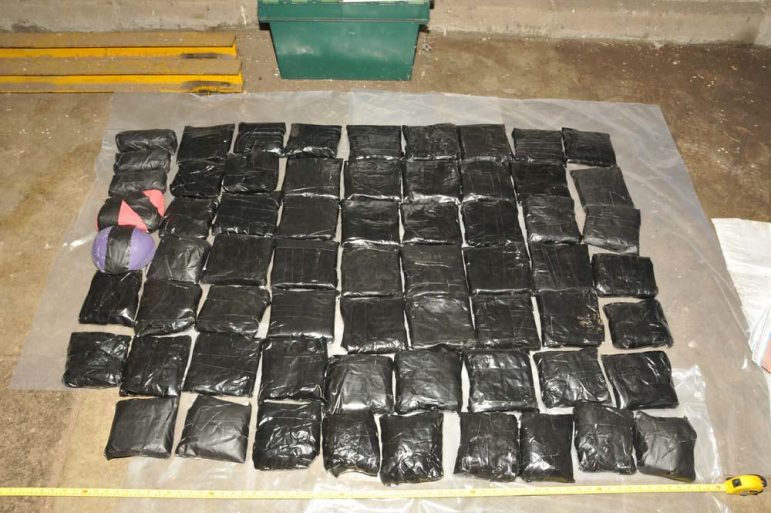It’s a rainy Saturday night, and business is pretty slow at the piercing and tattoo studio where Rob Vincent works. So, Vincent relaxes by playing with the calculator on his phone.
“I just add different stuff up and multiply,” Vincent explains. “I just like finding out the answers.”
This nerdy hobby is new for Vincent. For years, the only math he did was figuring out how much heroin he could buy. For example: $50. That’s two bags of heroin with a bit of money left over for gas, Vincent calculates. He was a heroin addict for years, and it took him to some very dark places.
“I have had dope delivered to me by an eight-year-old boy,” Vincent says.
Vincent has been clean for almost two years, and now he works with the Jefferson County Drug Court Advocacy Council to help other addicts get and stay sober. He says he feels like a completely different person.
“I love it. It’s so much better. I can joked about stuff, and I can laugh,” Vincent says. “I spent five years pretty much without laughing. Ain’t gotta live like that no more.”
Cheap Drugs Hard to Resist
According to Vincent most addicts he works with tell him it’s difficult to stay sober when heroin is still so cheap – around $20 for a normal dose. Heroin overdose deaths are on the rise nationally. In Jefferson County, deaths increased by more than 140 percent in 2014. The numbers were shocking: Heroin caused or contributed to 144 deaths in 2014. Area law enforcement responded by increasing efforts to get traffickers and drugs off the streets, especially in Birmingham.
In October, U.S. Attorney Joyce White Vance announced that a coalition of law enforcement agencies in Alabama had made a huge drug bust.
“This morning, around six o’clock, a group of federal and local law enforcement officers dismantled a multi-million dollar drug trafficking operation, charged now with dumping heroin and cocaine onto the streets of our city,” Vance said at the press conference.
Law enforcement in Jefferson County confiscated money, property, and a lot of drugs: 12 kilograms of cocaine and 1112 doses of heroin. In all, police arrested 23 people.
But Vincent doubts it had much of an effect.
“The thing is, when they get one guy off the street, there’s three more ready to take his place,” he says.
Vincent says in all the years he was using, he would regularly hear about big busts, like in 2013, when police arrested more than 40 people. But, Vincent explains, on the street, the price and availability of heroin never changed.
“The market is very flooded in Birmingham,” Vincent says. “It’s just like supply and demand economics – when you flood the market, price goes down.”
Fighting Supply and Demand
Jeffery Miron, an economics professor at Harvard University, says Vincent is right.
“The facts are that the prices have stayed low,” Miron explains.
Miron has been studying the economics of the drug trade since the 1980s. He says for decades, even with all the raids and busts, the price of heroin hasn’t gone up.
“It’s a little puzzling, because of course these activities would normally be expected to raise the cost of producing and selling drugs,” Miron says. “You would expect the prices to be higher, but we don’t see that in the data.”
The problem is the busts only target the supply side, and, Miron says, dealers adapt. They find new ways to hide and transport drugs, and their adaptation is often faster than the police can catch.
Joyce White Vance says she’s seen this happen firsthand.
“One thing that we have all learned in law enforcement is this is not a problem that we can arrest our way out of,” Vance says. “We also have to address the demand for heroin.”
Now, Vance says, law enforcement agencies are expanding their strategy. Vance says her office is teaming up with researchers at UAB and community leaders to study drug addiction and expand treatment for heroin addicts. Health officials have also started training friends and family members of addicts to use a drug called naloxone to stop an overdose.
In terms of overdose deaths, it seems things may be getting better. Preliminary numbers from December show Jefferson County had just under 90 deaths from heroin overdoses. But, Vance says, those numbers can be misleading, because of a new problem.
“Apparently, the drug dealers are realizing that they can cut the heroin with other substances and make more money by doing that,” Vance explains.
One of the substances dealers use is fentanyl, a painkiller. Mixed with heroin, fentanyl is deadly, and it’s not yet known how many drug overdose deaths are due to this fatal mixture.
Photo by National Crime Agency

